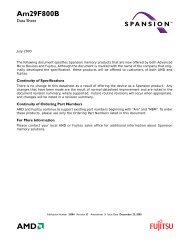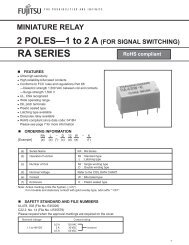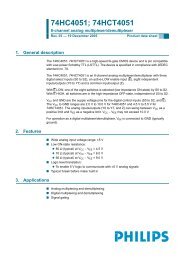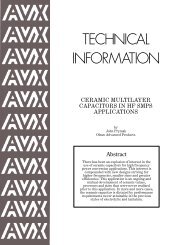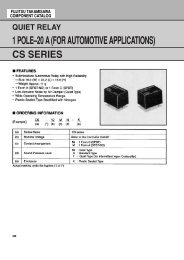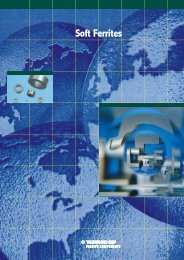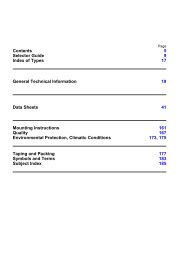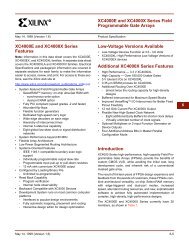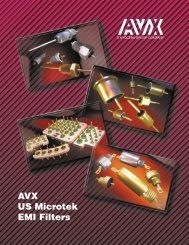Surface Mount Zero Defect Design Check List - RYSTON Electronics ...
Surface Mount Zero Defect Design Check List - RYSTON Electronics ...
Surface Mount Zero Defect Design Check List - RYSTON Electronics ...
Create successful ePaper yourself
Turn your PDF publications into a flip-book with our unique Google optimized e-Paper software.
start as baseline documents. The most comprehensive<br />
set of standards is available from The Institute for<br />
Interconnecting and Packaging Electronic Circuits. The<br />
guideline of most interest will be IPC-SM-782, “<strong>Surface</strong><br />
<strong>Mount</strong> Land Patterns (Configurations and <strong>Design</strong><br />
Rules).” One thing to remember is that any industry<br />
association specification is arrived at through compromise<br />
by various members who may have little SMT manufacturing<br />
experience. IPC-SM-782 is a prime example of<br />
this, many land patterns were established to make it easy<br />
to create artwork without understanding the impact on<br />
yield. Just now members are doing a study to see if the<br />
patterns are usable; a bit late because the specification is<br />
in its final form. This is still a good base line document.<br />
The best source for pads is either users or vendors<br />
that have reliable, low defect solder joint histories<br />
that number in tens of millions. Certain IC and passive<br />
component vendors have this history but their pads are<br />
different from IPC-SM-782, but no compromise for ease<br />
of artwork generation was made at the expense of reliability<br />
or yields. Actually small components are more<br />
prone to soldering defects than larger parts due to their<br />
low mass and small termination surface area.<br />
Pads demand that they have some prior history, are<br />
symmetrical, and have been tested in the intended process.<br />
Always avoid “Universal Pads” because too much<br />
has been compromised. Texas Instruments and Signetics<br />
are good sources for IC pads with AVX and Bourns<br />
for various passive component pads. Once pads are<br />
chosen, test them in your manufacturing process, then<br />
thermal cycle and environmentally test the assembly.<br />
Trace Pad Interaction. Connecting traces to pads is<br />
one area where thru-hole design techniques are<br />
absolutely not applicable. Reflow soldering uses heat<br />
transfer from the PC board surface to the pads, reflowing<br />
the solder paste on to the component termination.<br />
Asymmetry in pad thermal mass results in drawbridges<br />
or missing solder joints of low mass components or solder<br />
migrating away from a solder joint during reflow.<br />
Vias or plated thru-holes present another major problem:<br />
capillary action of solder in the via can rob a pad of<br />
solder causing a starved or missing solder joint. A few<br />
common sense rules are in order:<br />
1) Limit the number of traces entering a pad to a single<br />
trace if possible to reduce solder migration.<br />
2) Symmetry is important. Balance the trace entry to<br />
a pad to minimize any induced component rotation.<br />
3) No vias or plated thru-holes in a pad: sucks solder<br />
out of the joint.<br />
4) Isolate ground planes from components with<br />
necked down conductors no closer than 10 mils or<br />
wider than 10 mils for passive device pads and no<br />
wider than 7 mils for active device pads.<br />
5) Isolate a via pad even further than ground planes<br />
due to capillary action. Pad separation should be no<br />
closer than 15 mils.<br />
There is a simple test to see if an existing design is<br />
manufacturable or to find potential defect sources with a<br />
problem board. Screening solder paste on the pads with<br />
a stencil and then reflowing the board without components<br />
will indicate if there are problem locations. Solder<br />
missing from pads after reflow is a prime sign for problems<br />
and allows close scrutiny of traces and pads. High<br />
yield demands that a board must have uniform solder on<br />
pads after reflow or rework will result. Remember,<br />
rework is hideous and must be avoided and is counter to<br />
reasons for adopting SMT.<br />
SOLDER<br />
MIGRATION<br />
SOLDER LANDS<br />
and TRACES<br />
Figure 3. <strong>Design</strong> Techniques to Avoid<br />
0.010" Max. (.25mm)<br />
0.010" Min.<br />
(.25mm)<br />
SOLDER<br />
MIGRATION<br />
DURING <br />
REFLOW<br />
COMPONENT<br />
ROTATION<br />
CAPACITOR<br />
0.015" Min.<br />
(.4mm)<br />
Figure 4. <strong>Design</strong> Techniques That Work<br />
SOLDER<br />
LAND<br />
0.010" Max.<br />
(.25mm)



